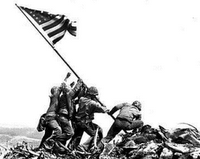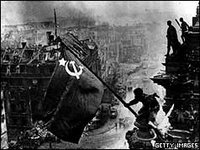This is an extract from his article.
Images of Victory

One of the most enduring images of WWII was the raising of the US flag on Iwo Jima - a photograph taken by Joe Rosenthal on 23 February 1945. Rosenthal had followed a US Marine group up to the summit of Mount Suribachi, a volcano on the southern tip of the island, and whilst the fighting was ongoing he snapped six men raising the Stars and Stripes.
It now appears this was the second flag raised on the spot, a smaller flag having been erected three hours earlier. Rosenthal's picture won him instant fame and many awards, but a strained relationship with the US Marines who had raised their flag earlier. Enormous controversy arose as to whether the image was staged or depicted a genuine snapshot, a "freeze-frame" during the battle.

Another iconic images of waris is the raising of a flag over the Reichstag . Representing Victory in Europe, it was shot by Soviet photographer Yevgeni Khaldei on 2 May 1945, as the last Nazi forces resisted in Berlin. It, too, is surrounded by controversy. The German parliament building was stormed and taken on 30 April, when a flag - specifically set aside for planting on the symbol of Nazi power - was held aloft that evening. Khaldei's image, was staged a couple of days later in daylight. Even that had to be retouched as at least one of the Red Army soldiers had been on a looting spree and was wearing several wristwatches.
There is no suggestion here that the pictures themselves were doctored - apart from the removal of a looted wristwatch or two - just that they "don't do what it says on the packet". The question we have to ask is, does it matter? Consider who the images are for. There are many "stakeholders" in a war. The soldiers, their loved ones, war workers, the enemy and so on. The images of Rosenthal and Khaldei communicated a different message to all these important groups in a way print or the human voice could never do. To the enemy, the message was loud and clear - throw down your weapons, you've lost. If the message is "assisted" in its composition, should we be surprised or offended?
Many of the famous war photographers of the 20th Century, including Robert Capa, who caught the agony of the assault troops on D-Day, and Larry Burrows, who worked in Vietnam, died in combat, camera in hand. This is not a suggestion that professionals compromise their integrity by doctoring images, that would be lying in celluloid, but as we are the consumers, we need to applaud the bravery of the Joe Rosenthals of this world for being there in the first place.
Photography
WWII
Manipulation
4 comments:
Interesting post. Interesting juxtaposition. It's a bit like writing an article about criminal activities and then showing Hannibal Lecter and a jailwalker as examples. Soviets were the Hannibal Lecters of photo fakery. They airbrushed Trotsky's image from every photo featuring Lenin and Stalin - that Berlin photo was nothing compared to other, monumental fakeries. But even here, the intention of faking the photo was to hide the fact that Soviet soldiers were looters.
The American were jailwalkers in that trade - all right, so there was another flag. Big deal. But the photo itself is genuine. No airbrushing. It doesn't hide anything about the true nature of American GIs.
Perhaps the most ridiculous case of Soviet fakery didn't even involve photos. In 1953, Beria was removed from power by Kruschev. All Soviet citizens who owned an encyclopedia were then ordered to cut out the text dealing with "Beria" and in its place cut and paste a ridiculously long article about.... the "Bering straits"
The camera does lie when taking photographs of me. Luckily, there's photoshop and airbrushing to save the day!
Your last sentence resonated with me about photographers being there in the first place to capture the moment. I heard a report this morning about a new trend that sees news media being taken hostage, and not released quickly like they were in the past. Instead the hijackers have an impossible list of demands in exchange for their prisoners.
FOX News Reporters Ambushed And Kidnapped
I will admit my edited extract gives even greater emphasis to the two photos than the article does. (I left out another image - that of Saddam's statue being toppled)
Rosenthal captured a genuine image - I believe that. That it wasn't the original flage is not a sin at all in my view. Khaldei did not. It was utterly staged:powerful as an image just not photojournalism.
Airbrushers extraordinaire and not just the USSR. The tale of Gottwald and the fur hat springs to mind.. Damned if I can remember the name of the purged comrade whose hat it was.
War reportage is not a cushy job at all.. quite a lot get killed (eg Sean Flynn (son of Errol) and Dana Stone - they were murdered by the Khmer Rouge)
I hope the reporters are released soon. The kidnappers know full well such demands will rarely be met.
Post a Comment